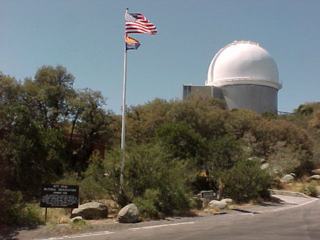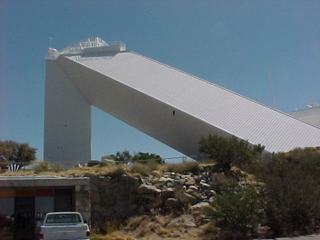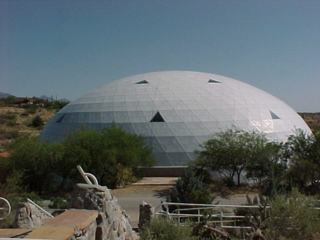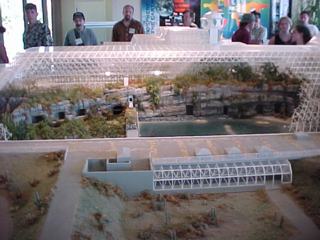






Selected Articles from the
June 2000 Odyssey
Editor: Terry Hancock
ISDC
Seth Potter
The 2000 International Space Development Conference was held May 26-29 in Tucson, Arizona. The host chapter took full advantage of its location, which is in the midst of a great deal of scientific and space-related research, by providing tours of such sites as the Kitt Peak National Observatory, Biosphere 2, and the Pima Air and Space Museum. Another aspect of the location that conference organizers paid tribute to was that it was the site of the founding of one of the National Space Society's predecessor organizations, the L5Society.
 |
| Kitt Peak Observatory. Photograph courtesy Craig E. Ward. |
Bill Weigle opened the conference on Friday by recounting the formation of the L5 Society 25 years ago. Much of the inspiration for this organization came from the space settlement studies of the late Princeton University physicist Gerard O'Neil. The organization later combined with the National Space Institute to NSS. In this way, the membership base of L5 was combined with the funding of NSI.
Weigle then introduced Apollo 11 astronaut Buzz Aldrin, who spoke on "Evolutionary Public/Private Transportation," which he hoped would pave the way for ordinary citizens to travel to space. Dr. Aldrin's talk was followed by Arizona Congressman Jim Colby, who spoke of his sponsorship of the Launch Services Purchase Act as well as his efforts to prevent NASA funding cuts for planetary missions. He expressed appreciation to space advocates for their efforts in contacting congressional representatives and discussing these issues.
Chapters Assembly met on Friday evening. It was particularly well attended with many chapter leaders present. OASIS was represented by Seth Potter and Mark Hopkins. There, Chapters Assembly President Peter Kokh suggested that if chapters can assist one another, then the load on NSS Headquarters can be reduced. NSS Board Member Bruce Mackenzie discussed a web site that will be available for chapters that need free server space. There was a discussion of how NSS can support chapters in search of new members. Among the suggestions were to periodically send out mailing lists of local members to the chapters, or to notify chapters of new NSS members in their area.
 |
| Solar Telescope at Kitt Peak Observatory. Photograph courtesy Craig E. Ward |
The technical sessions were divided into two parallel sessions. This maintained focus, while providing choice. In addition, various organizations had displays outside the meeting rooms. Among them was Silicon Graphics, Inc., which had a space shuttle landing computer simulation. The technical sessions had a great deal of variety, ranging from near-term concepts to advanced ideas. Speakers were from government, industry (both large and small companies), educational institutions, and the space advocacy community. In addition to space hardware design and space development concepts, several of the talks were on space medicine and biology.
Robert Forward spoke on the use of tethers for space transportation. Robert Zubrin spoke on "1% for the future," advocating that 1% of NASA's budget be allocated for Lunar/Martian human-enabling technology development. NSS Membership Vice President Jeffrey Liss elaborated on this idea. OASIS Secretary and Membership Chairman (as well as NSS Board Member) Robert Gounley spoke on the Deep Space 1 mission. The goal of this mission is to test 12 high-risk future technologies at relatively low cost. Its mission is to take images of asteroid Braille. An extended mission to another asteroid and/or two comets may be considered.
Saturday's luncheon speaker was NSS Board of Governors Member John Lewis, of the University of Arizona. Dr. Lewis is a renowned author on the subject of asteroids. In his talk, he discussed the vast wealth of resources available on those bodies.
Technical talks continued on Saturday afternoon with NSS Senior Vice President Robert Zubrin who discussed the Mars Arctic Research Station, which is a simulated Mars habitat on Devon Island in northern Canada. OASIS President Seth Potter spoke on "Alternative Architectures for Commercial Space Solar Power," based on a study being done at the Boeing Company. Marianne Dyson spoke on the International Space Station.
On Sunday morning, Peter Kokh spoke on space settlements. He stated that a possible economic driver for space settlements might be solar power satellite (SPS) construction, but that perhaps only 10% of the workforce in a settlement would actually be involved in SPS construction. The other 90% would produce goods and services for one another.
The NSS Awards Banquet was held on Sunday evening. OASIS won an award for community service. The award recognized OASIS's many activities, including science programming at several science fiction conventions in the Los Angeles area. Our sister chapter, the Orange County Space Society, won an award for its tribute to the memory of space tourism advocate Charlie Carr. OCSS had arranged for a vial of Charlie's cremated remains to be flown into space.
Technical talks continued on Monday morning. Several had an educational theme: Carol Redfield of St. Mary's University in San Antonio, Texas, spoke on "Tips for Getting Space Curricula in Schools." Richard Poss, a humanities professor at the University of Arizona, spoke on "Gaining Common Ground -- Greening the Polemics of Space Exploration." He advocated a dialog between space advocates and environmentalists, and suggested that exploration, development, and preservation of natural environments can all take place on the space frontier. NSS Board Member and author Marianne Dyson spoke on "Student Flight Opportunities." She recounted the experiences of the Illini (University of Illinois) NSS Chapter, whose members flew experiments on NASA's KC-135 zero-gee "Vomit Comet" aircraft.
The Tucson 2000 ISDC will be remembered for connecting the past of the L5 Society with a variety of visions of the future.
Have Space Suit, Will Travel
Terry Hancock
By far the most exciting thing I did at this year's ISDC was to attend Tom Jaquish's "Special Meeting for Those Who Personally Intend to Settle Space." Only six people stayed for this, which was at 10 PM on Sunday night, but it was really pretty fun.
Tom's idea, which he also expressed on the ISDC 2000 website, is that serious space enthusiasts should start developing their own "personal technologies" which they will need on the frontier. His example, was ham radio development, largely done by amateurs, which has contributed greatly to modern radios and cell phones. I likened this to the kind of free-participatory development that went into creating Linux and other free-software projects. He felt that certain technologies, such as "cheap access to space" (CATS) are beyond individuals, and best left to government and/or corporations, but that there are a number of things we can do for ourselves.
He also felt that development should be more "selfish" -- that is, directed at getting oneself into space, rather than merely "someone." This would bring development effort much more into focus for space activists.
 |
| Biosphere "lung" Photograph courtesy Craig E. Ward. |
After some discussion, we narrowed down the technologies of interest to four main items:
Spacesuits
We had a few leads on this, including a "fabric suit" developed at Ames Research Center, which works on a somewhat different principle than existing NASA suits. While existing suits use air-pressure to retain the body (as it retained on Earth), the fabric suit uses mechanical pressure in the form of a skin-tight, form-fitting strong suit. The fabric need not be airtight.
Biospheres
Despite our proximity to Biosphere 2, we had few actual leads on this. My opinion was that quite a bit of what you need on a space homestead is exactly the same as what you need on an Earth homestead, and that we could learn a lot by studying the methods used on Earth. Cheryl York (Oregon L5) felt that relatively little thought had gone into this,
 |
| Model of Biosphere 2 campus in Visitors' Center. Photgraph courtesy Craig E. Ward. |
Construction from Native Materials
Richard Richardson (Lunar Reclamation Society) mentioned some options for getting simulated Lunar soil ranging from expensive high-fidelity sources to the cheap, do-it-yourself approach. Tom mentioned a structural beam made from kevlar/fused-regolith composite. Bryce Walden (Oregon L5) and Cheryl mentioned the work being done at University of Arizona (Kumar Ramohalli, who also spoke at the conference). The Moon Miner's Manifesto is a pretty good source on this topic as well.
Power Production
Everything we do in space takes power, and the ability to generate it is the primary limitation on what we can do. So, I posed the question "what is the smallest factory that we can use to convert regolith to solar cells?". After a bit of discussion, regarding the virtues of photovoltaics versus solar-dynamic, and so on, we modified "solar cells" to "power-generating systems."
Interestingly, the division between photovoltaic and solar-dynamic also marked another division that came up -- whether we should start out with people up front, or robots, followed by people. I fell into the robots camp, and favor photovoltaics, myself, but I thought this was an interesting distinction. In any case, it seemed reasonable to me that a plant able to convert regolith to solar cells that was small enough to take to the moon ought to be manageable by an individual. Curiously, everyone at this meeting implicitly assumed the Moon as the target, no Mars, asteroid, or space-colony proponents attended.
We concluded that these are all possible areas for amateur development, and that development should be both competitive (in that different people pursue their own concepts) and cooperative (in that people openly share their results, allowing others to build on what they've started).
At this meeting, I volunteered to be a point of contact for this research, and collect the information (possibly on a website, although for the time being, we are just using e-mail). If anyone reading this wants to contribute or just stay informed, feel free to contact me at hancock@earthlink.net.
Following Helen Keller
Robert Gounley
While very young, Helen Keller lost both her sight and her hearing. As depicted in the play and motion picture The Miracle Worker, a dedicated instructor used sign language pressed into Helen's hand to teach speech to her. Helen went on to become a great spokesman for people with disabilities.
She made acquaintances all over the world. Some were suspected members of left-wing organizations. This troubled FBI Director J. Edgar Hoover who heard in her speeches language suggesting that rich people should "share the wealth" and other politically charged rhetoric. Hoover did what no other government official had dared to do: he ordered that Helen Keller be followed.
I am unaware that any information about Miss Keller's whereabouts proved vital to our national security. However, one has to wonder how the FBI agent assigned to this hazardous duty was chosen from the ranks of eager candidates. Anyone with the investigative skills of Inspector Clouseau would have sufficed, but it could easily have gone to the least senior man available. Whatever this agent's abilities, his name within the FBI must have been forever tagged as "the man who followed Helen Keller".
| L5 veterans panel. Photograph courtesy Craig E. Ward |
This is what I thought about while listening to a panel discussion at ISDC 2000. On the stage sat a half dozen people active in the early years of the L5 Society. Their reminiscences were easy and jovial, but they didn't truly become hilarious until the subject of perennial presidential candidate Lyndon Larouche came up.
Larouche and his organization are passionately pro-nuclear and have a gift for concocting conspiracy theories that shift with the wind. Back in the early eighties they took a keen interest in the young L5 Society and their calls for a space-faring civilization utilizing solar power satellites to drive Earth-bound industries. Fearful perhaps, that we were a threat to their New World Order, they sent agents to infiltrate L5 chapters.
Apparently these agents did not blend in easily. They tended to be unusually stiff and lacking in social skills. Even among space enthusiasts, they had odd notions and discretely asked questions about the chapters as if expecting to learn about channels of foreign support. This created back-room gossip within the chapters for a little bit, then the infiltrators disappeared.
The results of their surveillance did not become clear until the mid-eighties. Then, Lyndon Larouche dedicated a half-hour paid TV broadcast to lambaste the L5 Society as agents of the Queen of England and her bevy of dope pushers and international terrorists. The audience at ISDC, many of whom were L5 Society members in the eighties, burst out into uncontrollable laughter as a videotape showed Larouche levying more and more outrageous accusations.
What happened? My personal suspicion is that Larouche's agents came back from L5 Society meetings empty-handed. What could they tell their boss? That the organization they spent months spying upon really did believe in space development as a cure of the Earth's ills? That the members had a lot of energy, little money, and no outside sponsorship whatever?
Wouldn't it be better to make up a good story -- embellished with the most current Larouchian conspiracies -- and report back that they had important news to report?
The rest is history.
Copyright © 1998-2003 Organization for the Advancement of Space Industrialization and Settlement. All Rights Reserved.